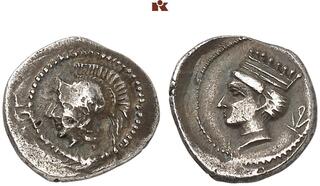| Fritz Rudolf Künker GmbH & Co. KG > Auction 402 | Auction date: 14 March 2024 |
| Lot number: 206 Price realized: 1,000 EUR (Approx. 1,089 USD) Note: Prices do not include buyer's fees. | Show similar lots on CoinArchives Find similar lots in upcoming auctions on |
| Lot description: LYCIA. Dynastische Prägungen. ARAXA AR-Trihemiobol, um 400 v. Chr. (?); 0,88 g. Athenakopf l. mit attischem Helm//Weiblicher Kopf l. mit Zinnenkrone. Müseler VII, 56 (dies Exemplar); Müseler in Gephyra 17 (2019), XVII.1.3 (dies Exemplar). Von allergrößter Seltenheit. Wohl Unikum. Doppelschlag auf dem Avers, sehr schön/fast vorzüglich Exemplar der Auktion Peus Nachf. 326, Frankfurt am Main 1989, Nr. 270 und der Auktion Peus Nachf. 376, Frankfurt am Main 2003, Nr. 760. Das am Oberlauf des Xanthos gelegene Araththihe – der Name könnte soviel wie ,Grenzstadt (Lykiens)' bedeuten (Carruba 1993, 15) – wurde von den Griechen Araxa genannt. Einer lykischen Überlieferung nach gebar Leto – die Lykier bezeichnen sie als ,Göttermutter' – ihre Zwillinge Apollon und Artemis bei Araxa (Merkelbach 2000). Insofern konkurrierte Araxa mit dem xanthischen Letoon, der Insel Delos, Ephesos und noch vielen anderen Orten, die allesamt die Niederkunft der Leto auf ihre Territorien verlegten. Nach dem griechischen Dichter Quintus von Smyrna (XI 20-26) soll Leto in Araxa im Geburtsschmerz die Erde mit ihren Händen aufgebrochen haben (anarexasa), wonach die Stadt ihren Namen erhielt. Die lykischen Dynastenmünzen zeigen die Göttin bekrönt. In Araxa war man so stolz auf diese Tradition von der Göttergeburt, dass auf sie mit dem Kopf der Leto angespielt wird. So klein diese Münze ist, so beeindruckend ist die Geschichte, die hinter ihr steht. [JN] Die Münzstätte Araxa war nur eine kurze Zeitspanne aktiv, was die Seltenheit der Prägungen erklärt. Die Tätigkeit der Münzstätte steht möglicherweise mit einer militärischen Auseinandersetzung zwischen Mithrapata und Artumpara in Verbindung. In diesem Fall hätte die Münzstätte Araxa die Aufgabe gehabt, die Truppen des Mithrapata mit Geld zu versorgen. Siehe Müseler in Gephyra 17 (2019), S. 62 f. Located on the upper course of the Xanthos, Araththihe – the name could mean something like 'town at the border (of Lycia)' (Carruba 1993, 15) – was called Araxa by the Greeks. According to Lycian tradition, Leto – the Lycians call her the 'mother of the gods' – gave birth to her twins Apollo and Artemis at Araxa (Merkelbach 2000). In this respect, Araxa competed with Xanthian Letoon, the island of Delos, Ephesos and many other places, all of which considered Leto to have given birth in their territories. According to the Greek poet Quintus of Smyrna (XI 20-26), Leto is said to have broken open the earth with her hands (anarexasa) in Araxa in the pain of childbirth, after which the city received its name. Lycian dynastic coins show the crowned goddess. In Araxa, people were so proud of this myth that it is alluded to with the head of Leto. As small as this coin is, the story behind it is all the more impressive. [JN] The mint of Araxa was only in operation for a short period of time, which explains why its issues are so rare. The activities of the mint might be connected to a military conflict between Mithrapata and Artumpara. If this was the case, the mint of Araxa would have had the task of supplying the troops of Mithrapata with money. Cf. Müseler in Gephyra 17 (2019), p. 62 f. Estimate: 500 EUR |  |



